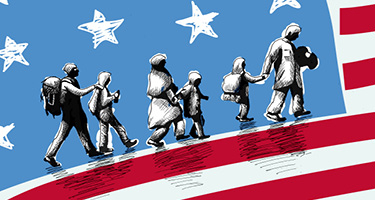Who Is Liable for a Pedestrian Accident?
It’s easy to assume you are safe walking on a sidewalk or crossing at a pedestrian crossing. You might also think you are safe navigating a parking lot. But pedestrians are more vulnerable because they don’t have the protection of a metal box, and if a driver is not paying attention to the road, or is driving under the influence, accidents happen.
Pedestrian accidents can result in serious injuries and even death. Determining liability in these types of accidents is complex, as there are often multiple parties that may share fault. Here is an overview of who may be liable in a pedestrian accident.
Pedestrian Accident Stats
Pedestrian accidents account for 18% of all motor vehicle accident fatalities, even with a multitude of protection devices in place, such as speed bumps, refuge islands, timed signals, lighting, and barriers. In 2022, there were 7,522 pedestrians killed, which is slightly higher than figures collected for 1975, even though in the intervening years, the number of pedestrians killed fell.
The number of child pedestrians killed has declined, thankfully, but deaths in the age group 20-44 have increased. Men are far more likely to be killed as pedestrians than women, with 70% of fatalities in 2022 male. It’s unclear why this might be, although the number of men walking late at night, which is a riskier time to be a pedestrian, is almost certainly higher.
Being drunk is certainly a factor in pedestrian deaths, as any experienced pedestrian accident injury lawyer knows. 37% of people killed had blood alcohol concentrations of 0.08% or higher. Even during the day, 23% of people aged 16+ tested positive for alcohol. The moral of this story is: day drinking is bad, but if the local bar calls your name, book an Uber for a ride home rather than staggering along the sidewalk.
Who is liable for a pedestrian accident? Now we’ve covered the stats, let’s look at who is liable.
Drivers
In most pedestrian accidents, the driver of the vehicle is likely to bear at least some liability. Drivers have a duty of care to drive in a safe manner and not put pedestrians at risk. Some key factors that point to driver liability include:
- Speeding - If the driver was exceeding the posted speed limit, they may be found negligent for contributing to the severity of the accident.
- Distracted driving - Drivers who are texting, eating, or otherwise distracted may not see a pedestrian in time to stop. This breach of reasonable care makes the driver liable.
- Failure to yield - Drivers must yield the right-of-way to pedestrians in crosswalks. Failure to do so that results in an accident means the driver did not exercise proper caution.
- Driving under the influence - It is illegal in all states to drive drunk or impaired. An intoxicated driver will almost certainly bear the brunt of liability if they hit a pedestrian.
So, in many pedestrian accident cases, the driver's negligence directly contributes to the collision and establishes liability. However, other factors may determine whether liability is shared.
Local Government
In some situations, a local government agency like a city, county or state may share liability for a pedestrian accident. This can happen if the government entity failed in its responsibility to maintain safe infrastructure:
- Poorly designed intersections - If a pedestrian crossing was not properly marked or designed, it can increase accident risk.
- Lack of traffic control devices - Things like stop signs, traffic lights and crosswalk signals help protect pedestrians when properly used. If they are absent, it could be a factor in liability.
- Badly maintained roads - Governments are tasked with keeping roads, signs, and markings in good repair. If they knew about a dangerous condition like a faded crosswalk and failed to fix it, liability may be established.
If there is an accident involving a pedestrian and government negligence regarding road design or conditions contributed to the risks, they may bear some percentage of the liability.
Property Owners
Sometimes a pedestrian accident occurs adjacent to a privately owned property. In these cases, the property owner could be liable if:
- They failed to maintain areas like sidewalks and parking lots that pedestrians cross. Issues like large cracked or holes can lead to falls and injuries.
- Poor lighting on the property made it hard for pedestrians to be visible and drivers to see them. Inadequate lighting can increase accident risk after dark.
- Objects on their property like landscaping or signs obstructed visibility for both pedestrians and drivers.
- The overall design of entrances and exits made it unnecessarily difficult or dangerous for pedestrians to navigate.
Property owners must keep their property safe with adequate maintenance, lighting and visibility. If an accident occurs and these factors played a role, the property owner shares liability under premises liability laws.
The Pedestrian
As already mentioned, in some cases, the pedestrian themselves may hold some comparative liability for their injuries if they contributed to the accident in an unreasonable way, such as:
- Crossing outside of a crosswalk in an area with light traffic and clear visibility. This still requires drivers to exercise proper caution.
- Distractions like texting or wearing headphones when crossing. This could prevent them from noticing oncoming vehicles.
- Attempting to cross very fast-moving traffic when there is no crosswalk.
- Crossing while intoxicated, which could impair judgment and reaction time.
People do need to take reasonable care when near roadways. But drivers still have a duty to avoid collisions, so pedestrian negligence plays little role in most accident cases.
Determining Fault Requires a Thorough Investigation by a Pedestrian Accident Injury Attorney
As the above discussion shows, liability in a pedestrian accident case can rest with multiple parties depending on the specific circumstances. To determine fault percentages, a detailed investigation needs to be conducted by your pedestrian accident lawyer, including:
- Analysis of all physical evidence like skid marks.
- Review of any video footage that captured the collision.
- Examination of the accident location to check for potential defects.
- Toxicology reports on any potentially impaired parties.
- Statements from witnesses who saw the events unfold.
- Confirmation that all vehicles and drivers involved were following applicable laws.
Los Angeles Pedestrian Accident Lawyers from Karns & Karns Personal Injury and Accident Attorneys can help pedestrians who are injured can establish where fault lies so they can pursue a justified legal claim and receive proper compensation from those responsible. This provides resources for medical bills, lost income, and pain and suffering damages.
If you’ve been hurt in an accident as a pedestrian, a Pedestrian Accident Lawyer Los Angeles from Karns & Karns Personal Injury and Accident Attorneys can protect your rights.
Call us today on 800-4THE-WIN (800-484-3946) for advice today.
















